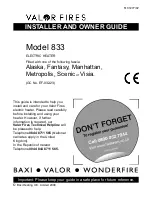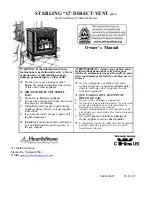
Safety Instructions
TM21PATHTRSS1
PLEASE READ AND UNDERSTAND THIS ENTIRE MANUAL BEFORE ATTEMPTING TO
ASSEMBLE, OPERATE OR INSTALL THE PRODUCT.
1.
The installation must conform with local codes or, in the
absence of local codes, with the National Fuel Gas Code,
ANSI Z223.1 /NFPA 54, Natural Gas and Propane Installation
Code, CSA B149.1, or Propane Storage and Handling Code,
B149.2.
Minimum clearance to the combustible materials is 3.67 ft.
(1100 mm).
2.
Perform a leak test with a soapy solution:
To check gas connections.
After connecting a new cylinder.
Upon re-assembly after disassembly.
Please refer to the leak test procedure indicated in
this instruction manual on page 12.
Replace the hose assembly prior to the appliance being put
into operation if there is evidence of excessive abrasion or
wear, or if the hose is damaged. The pressure regulator and
hose assembly supplied with the appliance must be used.
The replacement hose assembly/ regulator shall be that
specified by the manufacturer.
3.
If you do not feel the heater is on a stable surface, use a
ground screw to fix the base of the heater on the surface
where the heater is installed. Fix the base on an incline no
wider than 15 degrees.
4.
Place the propane hose with regulator assembly out of
pathways where people may trip over it or in areas where
the hose will not be subjected to accidental damage.
5.
Materials or items when stored under the heater will be
subjected to intense heat and could be seriously damaged.
6.
Clothing or other flammable materials should not be hung on
the heater, or placed on, under or near the heater .
7.
Children and adults should be alerted to the hazards of high
surface temperatures and should stay away to avoid burns
or clothing ignition.
8.
Young children should be carefully supervised when they
are in the area of the heater.
9.
Any guard or other protective device removed for servicing
the heater must be replaced prior to operating the heater.
10. Installation and repair should be done by qualified service
person. The heater should be inspected before use and at
least annually by a qualified service person.
11.
More frequent cleaning may be required as necessary. It is
imperative that the control compartment, burners and
circulating air passageways of the heater be kept clean.
12. Keep the appliance area clear and free from combustible
materials, gasoline and other flammable vapors and liquids.
13. Do not obstruct the flow of combustion and ventilation air.
14. Disconnect the cylinder when the appliance is not in use.
15. Storage of an appliance indoors is permissible only if the
cylinder is disconnected and removed from the appliance.
16. Store the cylinder outdoors in a well-ventilated area (not in a
building, garage, or other enclosed area) out of the reach of
children.
17. The cylinder used must include a collar to protect the
cylinder valve.
18. Keep the ventilation opening(s) of the cylinder enclosure free
and clear from debris. Use this appliance in a well-ventilated
space only. Do not use it in a building, garage, or any other
enclosed area.
19. Use this appliance in outdoor areas described below:
With walls on all sides, but at least
one permanent
opening at ground level and no overhead cover.
Within a partial enclosure that includes overhead
cover and no more than two walls. These walls may
be parallel, or at right angles to each other.
Within a partial enclosure that includes overhead
cover and no more than two walls. The following
shall apply:
a
One wall that is equivalent to at least 25%
of the total wall area is completely open.
b
30% or more in total of the remaining wall
area is open and unrestricted.
20. The LP-gas supply cylinder to be used must be
:
Constructed and marked in accordance with the
Specifications for LP-gas cylinders of the U.S.
Department of Transportation of Dangerous Goods
and Commission, CAN/CSA-B339, as applicable;
Provided with a listed overfilling prevention device;
and;
Provided with a cylinder connection device
compatible with the connection for the appliance.
Do not store a spare LP-gas cylinder under or near this
appliance.
23 Never fill the cylinder beyond 80 percent full.
Place the dust cap tightly on the cylinder valve outlet
whenever the cylinder is not in use. Install only the type of
dust cap on the cylinder valve that is provided with the
cylinder valve. Other types of caps or plugs may result in a
propane leak.
Inspect the visible portion of the hose before each use of the
appliance.
26 More frequent cleaning may be required as necessary. It is
imperative that the control compartment, burners and
circulating air passageways of the heater be kept clean.
Every part of the heater shall be secure against
displacement and shall be constructed to maintain a fixed
relationship between essential parts under normal and
reasonable conditions of handling and usage. Parts not
permanently secured shall be designed so they cannot be
incorrectly assembled and cannot be improperly located or
misaligned in removing or replacing during cleaning or other
servicing.
22.
.
24.
25.
.
27.




































